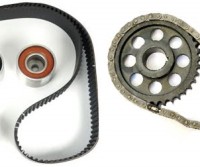
Most drivers ignore their car’s tachometer. It’s the big gauge next to your speedometer that shows your engine RPM, or rotations per minute.
While the device itself is a bit boring, it symbolizes something amazing. Those “rotations” are heavy, metal engine parts flying back and forth against exploding gasoline. When you’re hitting the on-ramp, that happens four thousand times per minute!
That speeding metal is orchestrated by a timing belt or chain, expertly engineered to keep those parts separated. If it breaks, those parts collide, and it’s not pretty.
Maintenance for belts and chains differs significantly! It’s important to know what your car has so you can avoid disaster.
Timing Belt
A timing belt is a ribbed, rubber belt that slides into gear grooves on one side of your engine. You usually can’t see it, as it’s covered to protect it from the elements.
Timing belts have many disadvantages. For one, their flexible material will eventually break. Furthermore, examining the belt requires removing a ton of other parts, so you can’t just chance it. Manufacturers have their own recommended replacement times, generally 60,000 – 100,000 miles.
However, timing belts have some pluses. They’re lighter and quieter, and much cheaper to manufacture. This makes them popular on both economy cars and high-performance sports cars.
Replacing the timing belt is a complex, lengthy procedure that can be quite expensive. Since it connects to several other hard-to-reach parts – particularly your water pump – your mechanic will usually replace multiple parts during the job. These higher upfront costs will save you money down the line.
Timing Chain
The timing chain is increasing in popularity, reaching even economy cars for Ford, Volkswagen, and Mazda. Its metal design means it rarely, if ever, breaks. Chains can withstand heavy duty or high-power applications, especially trucks. New technology means that chains can work in small cars with no performance or fuel economy loss.
However, timing chains aren’t perfect. They sometimes warp with time, requiring replacement. Furthermore, some manufacturers use plastic guides to keep the chain stable as it moves. These guides can wear over time and have disastrous consequences if they wear out. This was a particularly notable problem on certain Audis.
If you’re buying a new car, ask about its timing method! This will help you prepare for maintenance and keep your car running longer.
